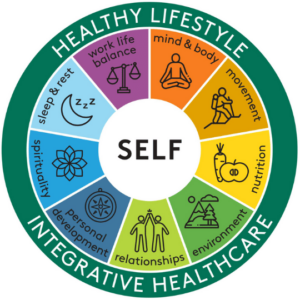Let’s be real – if you train hard, you’ve probably reached for an ibuprofen or two after a tough session. Sore knees, inflamed shoulders, brutal DOMS (delayed onset muscle soreness) after leg day… NSAIDs (non-steroidal anti-inflammatory drugs) are practically part of the gym bag starter kit for a lot of athletes and lifters.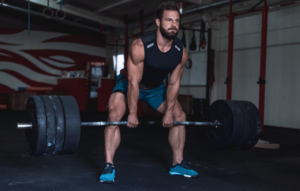
But here’s the question that keeps nagging at me – not just as a health coach, but as someone who understands that we have to respect the body’s natural rhythms: if inflammation is a key part of the muscle adaptation process, are we short-circuiting our own growth by trying to shut it down?
It seems like common sense. You lift heavy, you cause microtrauma to muscle tissue, your body responds with inflammation, and then it rebuilds stronger. In that equation, short-term inflammation isn’t the enemy – it’s the spark that later leads to the adaptation. So, when we silence that spark with anti-inflammatories, what happens to the fire?
That was my operating assumption. But when I went to the research to back this up, I ran into something surprising: the studies don’t really give a clear answer. In fact, many say NSAIDs don’t impair muscle growth and can actually help, at least in the short term. But something about that conclusion still doesn’t sit right. So let’s dig into this a bit.
Inflammation Is Part Of The Plan
First, a quick refresher on how muscle growth actually works. When you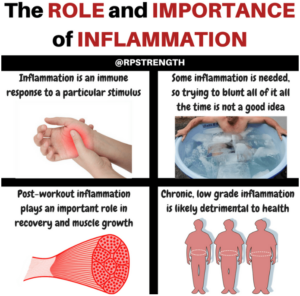 train, especially under heavy resistance or eccentric load, you create micro-tears in the muscle fibers. That damage signals your body to respond with inflammation. White blood cells flood the area, cytokines are released, and various growth factors kick in to begin the repair process.
train, especially under heavy resistance or eccentric load, you create micro-tears in the muscle fibers. That damage signals your body to respond with inflammation. White blood cells flood the area, cytokines are released, and various growth factors kick in to begin the repair process.
That inflammation phase isn’t just a side effect – it’s a signal. It’s what tells your body: “This tissue needs to be stronger next time.” Suppressing that response might mute the very thing that drives adaptation.
So, from a biological standpoint, it’s not hard to imagine that taking an NSAID post-workout could interrupt this conversation between your training stress and your body’s healing intelligence.
So… What Do The Studies Say?
Now here’s where it gets weird.
A lot of studies – like the immediate results you’ll find on Google Scholar – suggest that short-term NSAID use doesn’t significantly blunt muscle growth or performance. For example, a six-week resistance training study in young adults found no major difference in hypertrophy or strength between those taking ibuprofen and those taking a placebo.
Other studies even suggest that older adults may benefit from NSAIDs during resistance training, potentially because of their higher baseline levels of systemic inflammation.
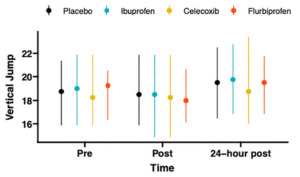
But let’s take a step back here. Who are these studies really serving?
Most of them are:
- Short-term (4–12 weeks)
- Performed on small sample sizes
- Conducted with general populations (not serious athletes or lifters)
- And narrowly focused on hypertrophy or 1-rep max strength as the primary outcome
What they don’t explore are things like:
- Long-term joint integrity
- Effects on recovery hormone signaling
- Gut lining and microbiome disruption
- Or downstream impacts on connective tissue and resilience
So while the headlines you’re most likely to find through Google say “NSAIDs don’t harm muscle growth,” what they really say is “In this short, narrow study, we didn’t see obvious harm.”
That’s not the same thing as “These are safe to use regularly for recovery.’ – AKA keeping them in your gym bag and using them every time you lift.
High Doses, Long-Term Use, And Compromised Gains
A 2017 study published in Acta Physiologica, which was oddly hard to find on Google, did something more relevant. Researchers gave young adults either high-dose NSAIDs (1200 mg ibuprofen) or low-dose aspirin during a resistance training protocol. The results? Those in the high-dose group saw significantly less muscle strength and hypertrophy gains than those in the low-dose group.
This suggests that dose does matter – and that long-term use at high levels could actively work against you.
This isn’t the only time a study has found results that would warrant caution with NSAIDs. We can see here that these researchers and doctors have found a similar cause for concern.
Of course, this doesn’t mean the occasional Advil is going to kill your progress. But it does start to paint a picture that chronic use, especially in high doses, is not benign.
Let’s Talk About Bias
Here’s another layer to consider: how many of the studies that pop up first on search engines are funded by pharmaceutical interests, or at the very least, reviewed through institutional lenses that aren’t exactly incentivized to make NSAIDs look bad?
Search engines like Google Scholar aren’t neutral. They’re algorithmically curated. And in a world where pharmaceutical companies have billions of dollars at stake in the pain-relief market, it’s naive to think there’s no influence on which research gets visibility.
This isn’t conspiratorial – it’s just good old logical thinking that has been proven time and time again. Especially when it comes to widely available drugs that people take without a second thought. If we’re going to be skeptical about food quality, EMFs, or environmental toxins, why give NSAIDs a free pass just because they’ve been normalized?
Common Sense Isn’t Pseudoscience
Here’s the thing: even if the science were more definitive in NSAIDs’ favor, I’d still be cautious. Because sometimes common sense gives us a better read than statistics.
Think about it. Nature doesn’t hand out free passes. Every process in the body – from muscle growth to immune response – is a complex, interconnected chain that we understand relatively little of. You don’t get to skip a step without paying a price somewhere.
Inflammation sucks. But it exists for a reason. It’s how we heal. Trying to silence that system every time it feels uncomfortable is like pulling the battery out of a smoke detector because you don’t like the sound. You’re not likely to solve much – you’re just ignoring the message.
Real Athletes, Real Risks
It’s also worth noting that NSAID use is rampant in the athletic world, not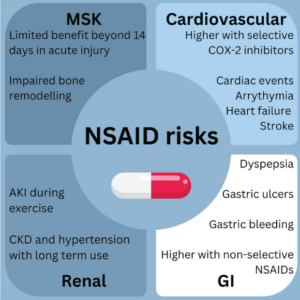 just for soreness, but for pushing through injury, overtraining, or sheer exhaustion. And that’s where the risks really stack up.
just for soreness, but for pushing through injury, overtraining, or sheer exhaustion. And that’s where the risks really stack up.
There’s concern that NSAIDs impair collagen synthesis and slow tendon healing. There’s also risk to gut lining, kidney function, and heart health, especially when combined with dehydration or stress.
So even if you’re not compromising hypertrophy directly, you may still be compromising your ability to sustain performance, heal connective tissue, or avoid chronic inflammation and joint degradation.
If you care about being an athlete for life, not just for a 12-week training cycle, those are not small concerns.
There’s No Free Lunch In Nature
The bigger point here is this: we have to stop thinking of the body as a machine with isolated parts we can tweak independently. It’s an ecosystem. Every shortcut you take comes with a tradeoff.
The idea that you can crush your workout, pop a few pills, and recover faster without consequence is a seductive lie. But in biology, there’s no such thing as a free lunch. Everything has a cost.
This is why I coach my clients to respect and learn from discomfort. To see soreness and inflammation not as enemies, but as evidence that the body is doing its job, or signals that something requires our attention. There are better ways to support recovery – nutrition, sleep, contrast therapy, compression, and movement. None of them skip steps. They work with your biology, not against it.
Final Thoughts: Train Hard, Recover Smarter – Naturally
So what’s the bottom line?
- Occasional low-dose NSAID use won’t necessarily wreck your progress, but it shouldn’t be your go-to.

- Chronic use, especially at high doses, does appear to interfere with long-term gains, recovery quality, and tissue integrity.
- Most studies that claim NSAIDs are safe are short, narrow, and often contextually irrelevant to serious athletes.
- “Common sense” still holds water: Inflammation is part of the adaptation process, and trying to mute it is probably sketchy at best.
If you’re serious about your gains, don’t fall for the promise of an easy fix. Lean into recovery that respects the body’s intelligence. The discomfort you feel today is part of the strength you’ll have tomorrow.
So the next time you’re sore and reaching for the medicine cabinet, pause. Ask yourself: Is this about comfort, or progress?
Because in the natural world, growth isn’t painless. And it’s never free.


